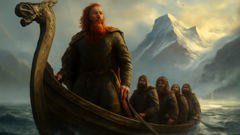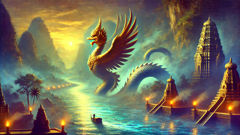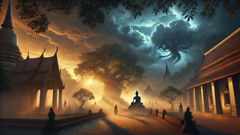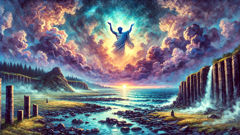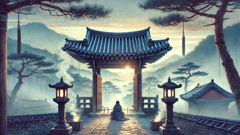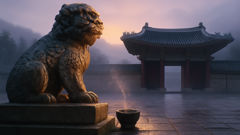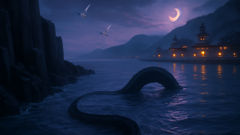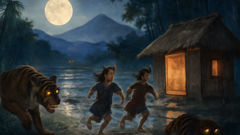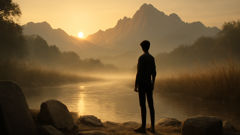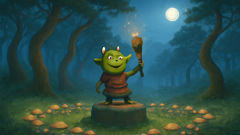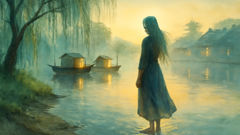Introduction
Long before modern maps gave names to the far reaches of the North Atlantic, the Norse people—famed for their restless courage and unyielding desire to carve a future from even the harshest lands—looked westward. Their world was one of towering cliffs and black-sand beaches, where glaciers gleamed beneath an endless sky and the sea was both road and adversary. Among them, few burned with as much iron resolve as Erik the Red. His name was whispered by hearthsides in Iceland and, later, shouted from new settlements across Greenland’s rugged coast. Erik’s story was not only about exile and vengeance, but also about forging new beginnings amid uncertainty, and about the legacy that outlasts even the longest winter. Born in Norway and raised in Iceland’s volcanic shadow, Erik’s destiny was shaped by relentless circumstance. When a fateful conflict forced him into outlawry, he refused to accept defeat. Instead, Erik turned his eyes toward the unknown, sailing with his family and followers into uncharted waters. Greenland awaited: a land as beautiful as it was brutal, where only the most determined souls could hope to thrive. Erik’s saga is one of ambition and adaptability—of learning to read the signs of wind and ice, to bargain with fate, and to gather others under a banner of hope. Yet the saga doesn’t end with Erik himself. His son, Leif Erikson, inherited the restless spirit of the Norse and would set sail for Vinland, a mysterious land across the sea where forests grew tall and rivers teemed with fish. In this telling, the human heart behind the legend shines through: the weight of leaving home, the fear and thrill of the unknown, the bonds forged in adversity, and the quiet triumphs that echo across centuries. As you read, imagine the crackle of driftwood fires, the salt tang of the wind, and the call of wild geese overhead. The saga of Erik the Red is more than a tale of exploration—it’s a testament to the indomitable spirit that drove the Norse to seek new worlds.
Exile from Iceland: The Fateful Beginning
In the middle of the tenth century, Iceland was both a land of promise and a crucible for the Norse soul. Its valleys and fjords sheltered scattered farms, where families told tales of Odin and Thor and measured the worth of a person by deeds as much as by lineage. Erik Thorvaldsson—soon to be known as Erik the Red—grew up amid these legends. His father, Thorvald Asvaldsson, had brought the family from Norway after being exiled for manslaughter, hoping for a new start beneath the ever-changing Icelandic sky. But blood feuds and harsh justice were as common in Iceland as in Norway. When Erik reached manhood, fierce and quick to defend his honor, fate turned on him. A dispute with neighbors over property boundaries—first snowdrifts trampled by cattle, then insults exchanged, then blows—spiraled quickly. Men fell, and soon, vengeance circled the Thorvaldsson home like wolves in winter. The Icelandic Althing, the island’s ancient assembly, held little patience for such strife. Erik was declared an outlaw for three years. His friends watched in silence as he loaded what he could onto a battered longship: axes and a battered shield, salt fish, a battered chest with his wife Thjodhild’s treasures, their children—young Leif among them—pressed close in the cold dawn.
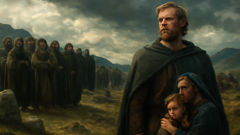
The sea was both trial and refuge. As Erik steered away from the familiar cliffs, his thoughts churned as restlessly as the gray water below. Where could he go, if not back to Norway? Rumors swirled among fishermen: far to the west lay a land glimpsed by Gunnbjörn Ulfsson, who had been blown off course by a storm decades earlier. No one knew if it was real—a green land or just an icebound dream. But Erik, too proud to return in shame, resolved to find it. The voyage westward was a test for even the bravest. Fog wrapped the horizon; icebergs drifted like silent ghosts; wind and wave hammered the hull. But Erik’s determination was unshakable. When hope flickered, he recalled his father’s words: "The gods help those who help themselves." When finally, after weeks adrift, his crew sighted a line of mountains rising from the sea, Erik felt a jolt of wild hope. They landed on a rocky shore fringed with ice and moss. The air bit with cold, yet wildflowers nodded in the meadows. They camped in the shelter of a cliff, gathering driftwood and hunting seals. Erik explored the coastline, discovering fjords that shimmered in the long summer light and valleys where hardy grass pushed through frost.
Winter came hard. Blizzards battered their crude shelters; hunger gnawed at bellies; a man was lost to the ice while fishing. But Erik kept his people together, teaching them to trap Arctic foxes and mend sails with sinew. In the spring, he sailed further south, mapping bays and inlets. He returned to Iceland as his outlawry ended, his ship heavy with walrus ivory and tales of a new land. He called it "Greenland," hoping that the name would entice others to join him.
And join him they did. Stories spread like wildfire: Greenland, a place of freedom for those outcast or restless, a land of untapped riches. Erik became a leader once more—not by inheritance, but by sheer force of will. In a fleet of 25 ships, families sailed west. Not all made it; some were lost to storms or ice. But enough survived, scattering along Greenland’s fjords and founding new settlements that would endure for generations. The first winter was bitter, testing every lesson Erik had learned in exile. Yet slowly, houses rose from turf and stone. Sheep grazed beneath watchful eyes. People gathered in smoky halls, sharing laughter and sorrow by firelight. Erik’s red hair turned silver, but his legend only grew.
Exile had been meant as punishment. Yet for Erik the Red, it became a forge—a crucible that hardened his resolve and set in motion the Norse expansion that would change the map of the known world.
Forging a Home: Greenland’s Harsh Promise
Greenland was unlike anything Erik or his followers had ever known. Its name was a promise, but its reality was a challenge. The coast was jagged with granite and glaciers, its fjords deep and cold, its brief summers haunted by the shriek of seabirds and the bleating of sheep. Erik chose Brattahlid as his homestead—a green patch nestled at the head of a fjord, where mountain walls broke the wind and streams flowed clear. Here, he built a longhouse of turf and driftwood, thick-walled to hold in heat. The first settlers arrived in fits and starts, sometimes in summer caravans of ships, sometimes alone after being blown off course. Erik welcomed them all. For years, they worked side by side: hauling stones, digging sod, learning to coax barley from the rocky soil, and fishing for cod in icy waters. In winter, life shrank to the glow of hearth fires. Erik’s hall filled with laughter and tales of Norway and Iceland, but also with worries. Wolves prowled the outskirts; food sometimes ran low; sickness took the weak. Yet no one dared speak of leaving. Erik’s stubborn confidence was a beacon.
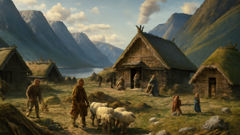
As the years passed, the settlement grew. More families arrived—some escaping blood feuds, others simply seeking hope. Fields were fenced, goats and sheep grazed, and a church rose at Thjodhild’s urging. The land demanded much: men hunted walrus and seal, trading ivory and hides for grain from passing merchants. They learned to watch the sky for sudden storms, to store fish against famine, to mend wounds with herbs and prayer. Erik ruled with a firm hand, settling disputes and organizing hunts. He was fair but fierce, never forgetting what exile had taught him. His wife Thjodhild, wise and patient, became a pillar for the women—teaching them how to dye wool with moss and keep children warm through endless nights.
There were moments of triumph: a bumper barley harvest, a successful drive of caribou, a wedding that united two rival families. But there was loss too—a fire that swept through a barn, an avalanche that buried a byre, an epidemic that stole children in the dark of winter. Through it all, Erik remained unbowed. "We shape the land as it shapes us," he told his children. Young Leif listened well, learning to read ice flows and stars, to build trust among men hardened by hardship. One spring, when a ship from Norway brought word of distant kings and the spread of Christianity, Greenlanders debated change by candlelight. Thjodhild converted first, building a tiny church beside her hall. Erik refused; the old gods had seen him through too many storms. But his son Leif listened, torn between tradition and curiosity.
Greenland became more than a place of exile—it was a new Norse world, stubbornly carved from frost and stone. The settlers celebrated Yule with feasting and song, their laughter echoing off the cliffs. Children learned to ski on carved bones; men tested their courage in wrestling matches and boat races. Erik’s hair was white when he saw his grandchildren playing in meadows he’d once thought barren. He wondered if someday they’d look beyond even Greenland’s horizon.
The Call of Vinland: Leif’s Journey West
Time passed as Greenland’s settlements grew sturdy—some thriving, others fading into ruin as the cycles of hardship and hope continued. Erik the Red’s saga had become legend, but it was his son Leif who would push beyond the edge of every known map. Leif had grown tall and thoughtful in Brattahlid, a man of keen eyes and steady hands. He had learned from both his father’s boldness and his mother’s quiet wisdom. When ships from Iceland or Norway arrived with news of distant lands and new faiths, Leif listened. Christianity’s message stirred something in him, though he never fully cast off the old gods.
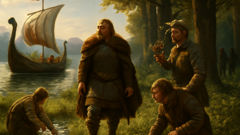
Rumors swirled among the traders and seafarers: Bjarni Herjólfsson, blown far off course, had glimpsed forested shores beyond Greenland—a land of gentle hills and wild grapes, unlike any place in the north. Leif’s mind caught fire. He outfitted a sturdy ship and gathered a crew—stout men who trusted his judgment and shared his hunger for discovery. Before leaving, he sought his father’s blessing. Erik hesitated, torn between pride and fear. A fall from horseback injured Erik badly; he took it as a sign he should not sail. So Leif set out alone at last, steering west into the unknown.
The voyage was fraught with peril. They skirted ice floes and endured days of thick fog. Seals surfaced beside the ship; seabirds wheeled above. When at last they found land—a rocky shore dense with birch trees—Leif named it Helluland, "Stone Slab Land." They sailed south to a place carpeted in forests and meadows, which they called Markland, "Forest Land." Further still, they discovered a land of gentle rivers, salmon-rich streams, and wild grapevines. Leif named it Vinland. The air was milder than in Greenland, and the sun hung longer in the sky. Here, they built a small settlement—halls of timber, enclosures for cattle, storage pits for fish and berries.
The Norse spent a winter in Vinland, marveling at its bounty. They met native peoples—Skraelings—whose language was strange and whose ways were different. Trade was cautious at first: red cloth for furs, metal tools for baskets. But misunderstandings bred tension. A sudden clash left several wounded. Leif kept his crew safe and decided not to risk another season. They gathered samples—wood, grapes, stories—and sailed for home.
Leif’s return was met with wonder. The tale of Vinland spread through Greenland and Iceland like wildfire. Others followed in his wake—his siblings Thorvald and Freydís among them—each seeking fortune or escape. Some expeditions ended in blood; others vanished without a trace. But Vinland became a symbol—a whisper of possibility beyond the edges of Norse experience. Even as harsh winters pressed upon Greenland and old feuds reignited, the memory of those sunlit meadows across the sea kindled hope.
Erik did not live to see Vinland for himself. Age and injury bound him to Brattahlid, where he sat by the fire listening to Leif’s stories. Yet in his son’s journey, Erik saw the legacy of perseverance carried onward—a torch passed from one generation to the next, lighting a path beyond exile and hardship to discovery and wonder.
Conclusion
Legends endure because they capture something timeless—a spark of courage or hope that flickers in every age. Erik the Red’s saga is not just a tale of exile and hardship, nor merely an account of bold exploration. It is a living thread connecting generations who dared to dream beyond their limits. In Greenland’s wind-scoured fjords and Vinland’s sunlit forests, the Norse spirit found new ground to root itself, adapting, persevering, and leaving stories carved deeper than runes. As long as travelers gaze westward, longing for what lies beyond the known world, Erik and Leif’s saga will echo—reminding us that even out of exile, greatness can grow.

